112/3/D1
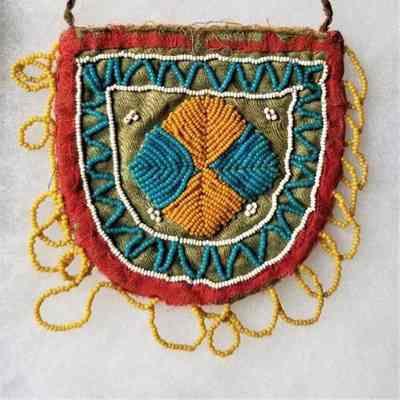
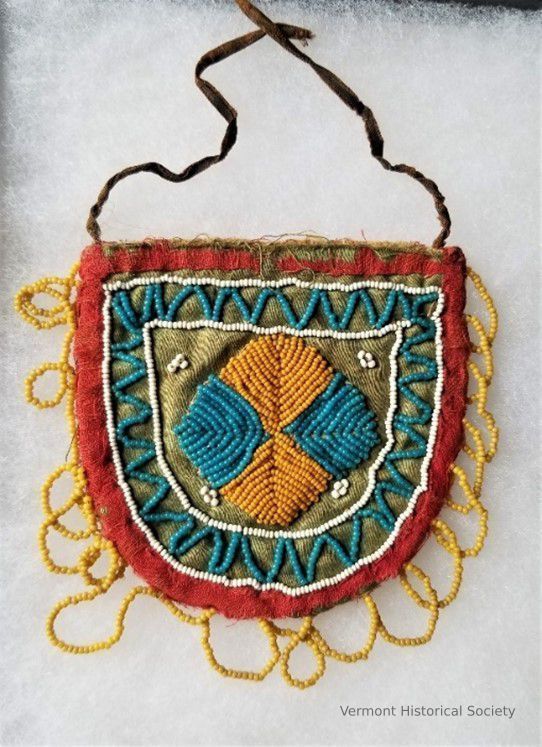
Bag
Name/Title
Bag
Lexicon
Description
Beaded trinket bag. Primarily blue, white, and yellow beaded in quatrefoil shape surrounded by zig-zag band. Yellow beaded loops around edge of bag.
Acquisition
Source (if not Accessioned)
Abenaki Cultural Conservancy
Ethnography
Made/Created
Date made
circa 1860
Entry/Object ID
L2024.3.133
Context
This small quatrefoil beaded design pouch with its beaded loop fringe is an important piece. This pouch employs larger, more colorful beads not as well sewn down as in the previous items in the beadwork collection. This is probably a decorative piece for sale to the settlers, and shows the potential of the quatrefoil design in early Abenaki tourist art. These little bags were made in huge numbers throughout the Northeast. Most are attributed to the Seneca (Haudenosaunee) but the quatrefoil is pure Wabanaki and commonly seen in the American Abenaki area with the zigzag motif, also in evidence on the pouch.
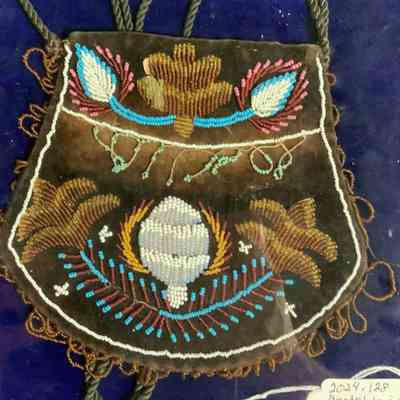
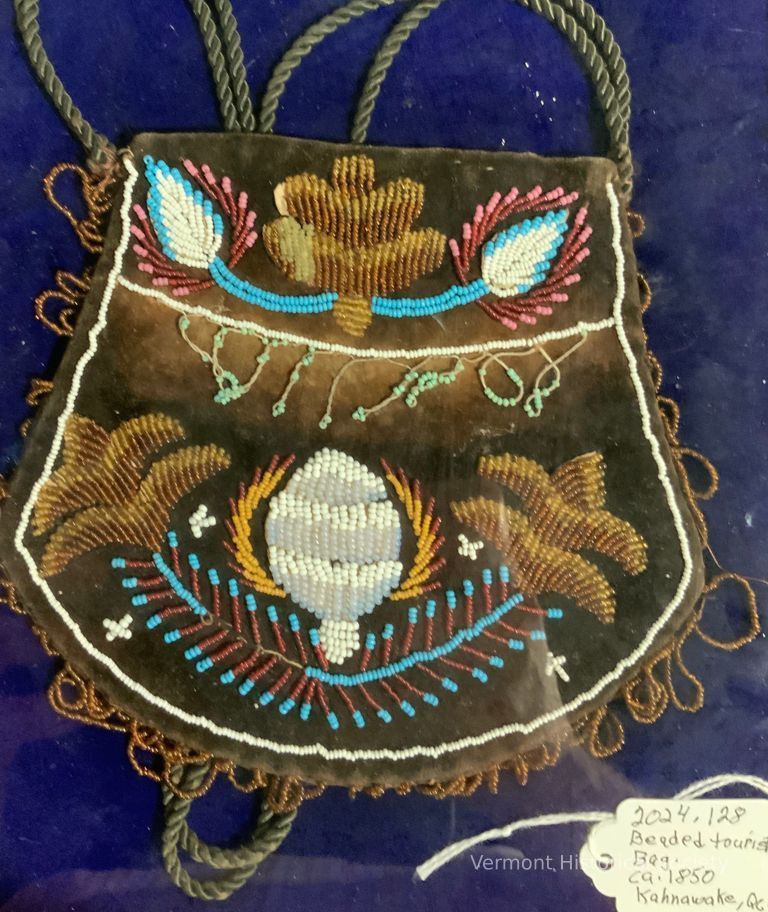
Beaded Bag
Name/Title
Beaded Bag
Lexicon
Description
Black, velvet bad with cord strap. Decorated with blue, purple, and brown beads in floral forms.
Acquisition
Source (if not Accessioned)
Abenaki Cultural Conservancy
Ethnography
Notes
Kahnawake
Made/Created
Date made
circa 1850
Entry/Object ID
L2024.3.128
Context
Possibly Kahnawake or Abenaki

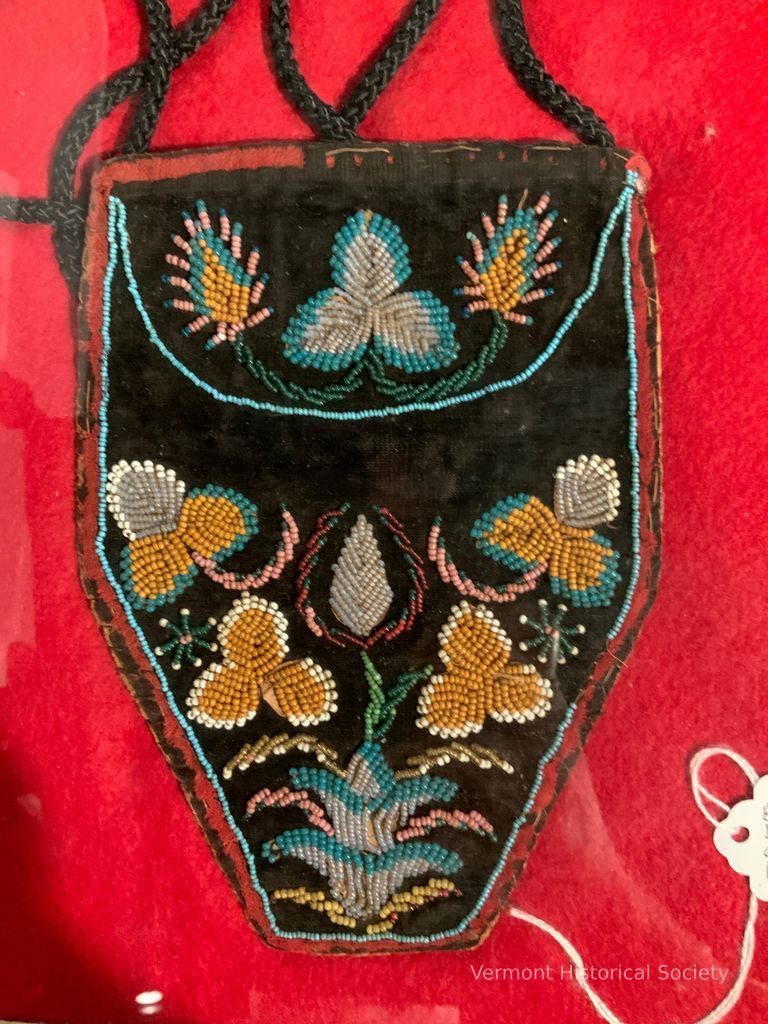
Beaded Bag
Name/Title
Beaded Bag
Lexicon
Description
Black velvet bag with predominantly blue beaded design. Three-leaf flowers, thistles, and tiered flower. Red binding ribbon, mostly worn away.
Ethnography
Notes
Kahnawake
Made/Created
Date made
circa 1870
Entry/Object ID
L2024.3.126
Context
Probably produced for the tourist trade.


Beaded Pouch
Name/Title
Beaded Pouch
Lexicon
Description
Beaded pouch with flower and thistle design. Yellow, looped bead-work fringes the edges of the bag.
Acquisition
Source (if not Accessioned)
Abenaki Cultural Conservancy
Ethnography
Entry/Object ID
L2024.3.143
Context
This pouch exhibits three of the most diagnostic bead-work style motifs, very similar to two moccasin fragments with a Waterville, Vermont provenance.
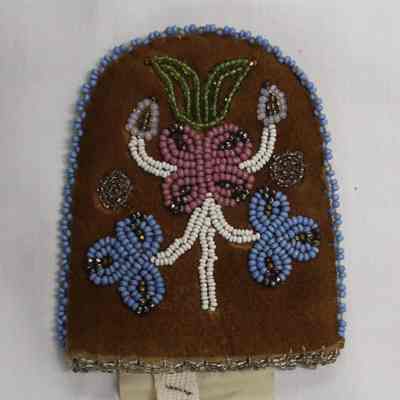
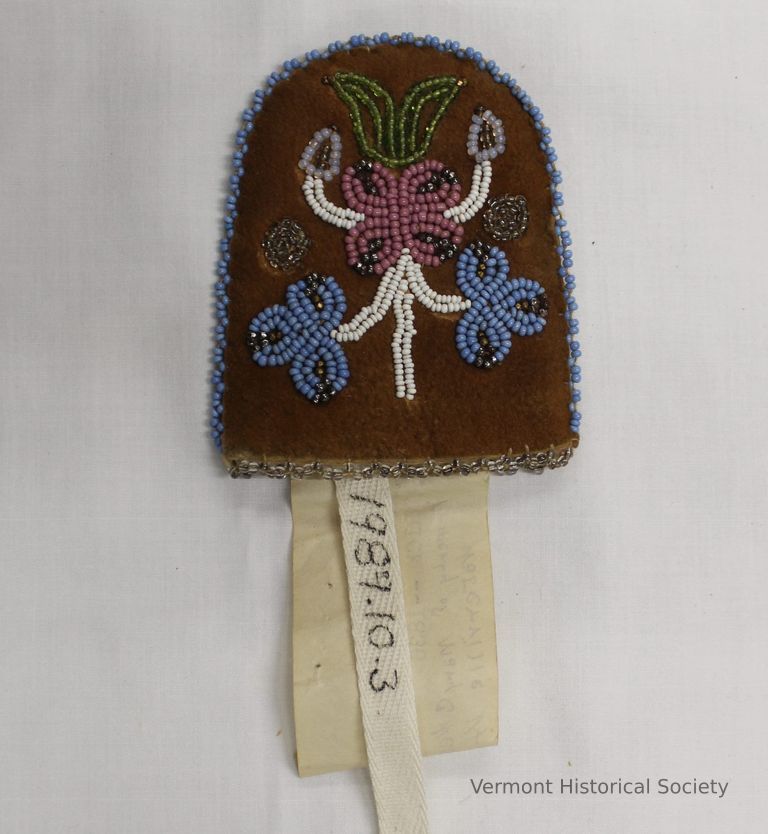
Compass Case
Name/Title
Compass Case
Lexicon
Description
Leather compass case with beadwork. The light brown suede leather is camel color while the fabric lining is cream color with pink stripes (much like pillow ticking). The beaded pattern is different on the front and back.
The beadwork motif on one side depicts a green flower cradling a silver ball or bud. Below the flower are two white branches surmounted by silver buds. The branches extend from a white stem that emerges from a light purple, figure-eight form. Below the purple form are four clear and silver leaves or pods.
The other side has a similar green flower, but without the silver ball. The flower sits atop a pink quatrefoil design. Two white branches emerge from either side of the quatrefoil and are surmounted by light purple and silver buds. A white stem descends from the base of the quatrefoil along with two white stems that curve outward. These stems are surmounted by light blue trefoil designs. Two clear circles flank the central motif.
Open edges are lined with clear beads. Closed seam is lined with light blue beads.
The beadwork motif on one side depicts a green flower cradling a silver ball or bud. Below the flower are two white branches surmounted by silver buds. The branches extend from a white stem that emerges from a light purple, figure-eight form. Below the purple form are four clear and silver leaves or pods.
The other side has a similar green flower, but without the silver ball. The flower sits atop a pink quatrefoil design. Two white branches emerge from either side of the quatrefoil and are surmounted by light purple and silver buds. A white stem descends from the base of the quatrefoil along with two white stems that curve outward. These stems are surmounted by light blue trefoil designs. Two clear circles flank the central motif.
Open edges are lined with clear beads. Closed seam is lined with light blue beads.
Acquisition
Accession
1989.10
Ethnography
Relationships
Related Person or Organization
Westcot, Mary C. Wilbur
Person or Organization
Related Places
Place
Waterville
Town
Lamoille County
County
Vermont
State/Province
United States of America
Country
North America
Related Publications
Log Cabin Days of Coit's Gore and Waterville
Publication
Made/Created
Date made
circa 1836
Dimensions
Materials
Material
Leather, Beads, Linen
Entry/Object ID
1989.10.3
Context
According to Isaac Merrick's daughter, Esther Merrick Wilbur, this compass case was made for him in 1836 by Abenaki Indians living in the area of what is now Waterville, Vermont. Isaac Huse Merrick (1796-1864) was born in Bedford, New Hampshire to parents who had recently settled after leaving Newbury, Massachusetts. His family was part of the second wave of settlers who moved first from the eastern shores of Massachusetts to New Hampshire and then on to northern Vermont.
Isaac Merrick is first recorded as living in Coit's Gore, the precursor to Waterville, Vermont (est. 1824) in the 1820 census. Family history, as published in a small volume by his granddaughter Mary Wilbur Westcot, place him in the area as early as 1807. There are many fanciful tales of Isaac that seem to blend fact with a healthy dose of fiction. Like any frontier settler of this time, his life would certainly have been daring and adventurous.
Isaac purchased 300 acres on a hillside above the Kelley River (now known as the north branch of the Lamoille). Family records state that his farm overlooked an "Indian settlement" of "wigwams" in the river valley. Isaac farmed the land and made a name for himself as a trader/smuggler. During this time, Britain enacted fairly stiff tariffs on goods crossing the Canadian border and many enterprising Vermonters took the risk of smuggling through the mountains for potential fortune. The family stories mention Isaac's partnership with Indians in these cross-border trading endeavors.
This small beaded case bears witness to this partnership with a beautiful Abenaki work of art designed to hold a European navigation device. The provenance of this item helps document an Abenaki community in the Waterville area in the first half of the 19th century as well as providing an example of stylistically distinct beadwork motifs.
Isaac Merrick is first recorded as living in Coit's Gore, the precursor to Waterville, Vermont (est. 1824) in the 1820 census. Family history, as published in a small volume by his granddaughter Mary Wilbur Westcot, place him in the area as early as 1807. There are many fanciful tales of Isaac that seem to blend fact with a healthy dose of fiction. Like any frontier settler of this time, his life would certainly have been daring and adventurous.
Isaac purchased 300 acres on a hillside above the Kelley River (now known as the north branch of the Lamoille). Family records state that his farm overlooked an "Indian settlement" of "wigwams" in the river valley. Isaac farmed the land and made a name for himself as a trader/smuggler. During this time, Britain enacted fairly stiff tariffs on goods crossing the Canadian border and many enterprising Vermonters took the risk of smuggling through the mountains for potential fortune. The family stories mention Isaac's partnership with Indians in these cross-border trading endeavors.
This small beaded case bears witness to this partnership with a beautiful Abenaki work of art designed to hold a European navigation device. The provenance of this item helps document an Abenaki community in the Waterville area in the first half of the 19th century as well as providing an example of stylistically distinct beadwork motifs.

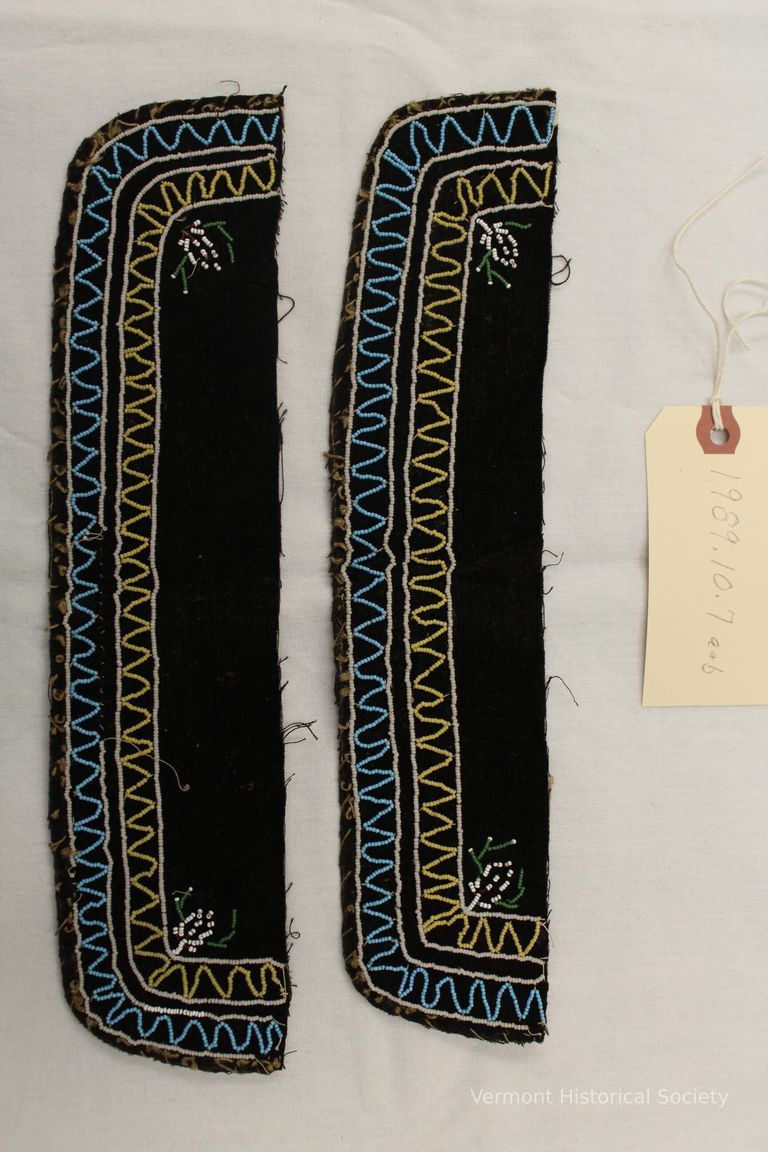
Cuffs
Name/Title
Cuffs
Lexicon
Description
Pair of beaded cuffs, probably from moccasins. The black velveteen fabric is decorated with white, yellow blue, and green beads. The motif features two zig-zag bands, blue on the outer and yellow on inner. Both bands are bordered with white beads. In each corner there is a white flower with green outer leaves or petals. There is evidence of an overcast stitch done in tan around the outside edge. Evidence of paper sandwiched between the two layers of velveteen can be seen on the reverse.
Use
These cuffs probably lined the foot opening of a pair of moccasins, most likely from the same moccasins as 1989.10.6a-b (vamps).
Acquisition
Accession
1989.10
Ethnography
Relationships
Related Person or Organization
Wilbur, Moses (1841-1903)
Person or Organization
Related Places
Place
Waterville
Town
Lamoille County
County
Vermont
State/Province
United States of America
Country
North America
Made/Created
Date made
1841-1903
Dimensions
Dimension Description
Overall
Materials
Material
Silk, Cotton, Paper, Glass
Entry/Object ID
1989.10.7a-b
Context
These particular pieces came into the Vermont Historical collection as part of a group of items from the Wilbur family. The envelope containing the cuffs, along with vamps 1989.6a-b, had the inscription, "James Wilbur's Beadwork." For a number of years, James Wilbur was listed as the maker with an origin date of 1840. Upon further research and close analysis of the beadwork, it's most likely these date from the 1820s and the inscription on the envelope is that of ownership as opposed to manufacture.
The Wilbur family was one of the early settler families in Waterville. 19th century Waterville written histories as well as recorded oral histories indicate there was a sizeable Abenaki village along the shores of the North Branch of the Lamoille River (called the Kelley River at the time). Wilbur's father-in-law, Isaac Merrick, is known to have partnered with Abenaki in his cross-boarder trade/smuggling in the 1810s and 1820s. A beautiful, Abenaki-produced, compass case belonging to Isaac Merrick is also part of this larger family gift. For more information on this relationship, please see object 1989.10.3.
It's highly likely that these cuffs, and the now-missing moccasins, were produced in the local Abenaki community and gifted or traded to the extended Wilbur family.
The Wilbur family was one of the early settler families in Waterville. 19th century Waterville written histories as well as recorded oral histories indicate there was a sizeable Abenaki village along the shores of the North Branch of the Lamoille River (called the Kelley River at the time). Wilbur's father-in-law, Isaac Merrick, is known to have partnered with Abenaki in his cross-boarder trade/smuggling in the 1810s and 1820s. A beautiful, Abenaki-produced, compass case belonging to Isaac Merrick is also part of this larger family gift. For more information on this relationship, please see object 1989.10.3.
It's highly likely that these cuffs, and the now-missing moccasins, were produced in the local Abenaki community and gifted or traded to the extended Wilbur family.
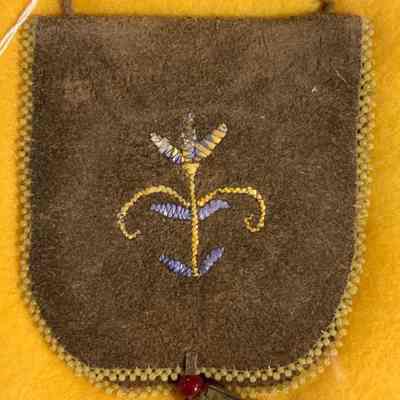
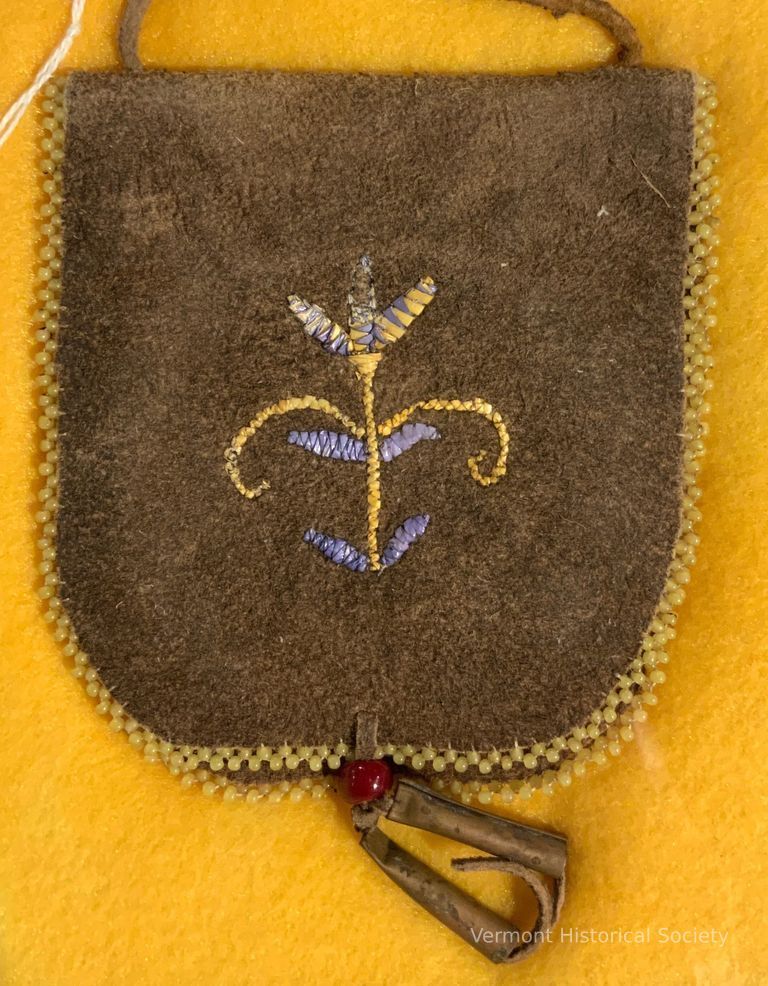
Mirror Case
Name/Title
Mirror Case
Lexicon
Description
a. Brown, hide pouch with small flower design made of dyed porcupine quills.
b. Round wood mirror
b. Round wood mirror
Acquisition
Source (if not Accessioned)
Abenaki Cultural Conservancy
Ethnography
Made/Created
Date made
circa 1850
Entry/Object ID
L2024.3.130a-b
Context
This was an unexpected find, originally from an old farmhouse in North Central New Hampshire. It has a leather front and flap and “blue/gray “bed ticking” back, giving it a 19th century date. It has a small but definite porcupine quilled design and holds a small round mirror. The research on these items is so sparse, there is no guarantee that this was made by the Abenaki community, but the pouch was not a souvenir purchased elsewhere and brought back to New Hampshire.
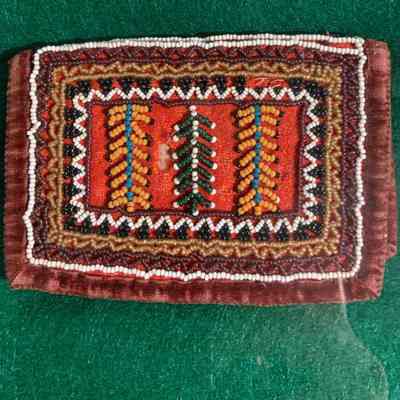

Needle Case
Name/Title
Needle Case
Lexicon
Description
Beaded needle case
Acquisition
Source (if not Accessioned)
Abenaki Cultural Conservancy
Ethnography
Made/Created
Date made
circa 1850
Entry/Object ID
L2024.3.127

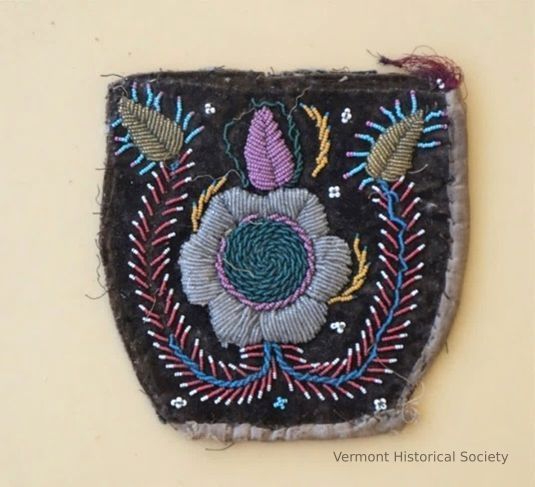
Purse Fragment
Name/Title
Purse Fragment
Lexicon
Description
Beaded floral design on black fabric.
Acquisition
Source (if not Accessioned)
Abenaki Cultural Conservancy
Ethnography
Made/Created
Date made
1840-1860
Entry/Object ID
L2024.3.134
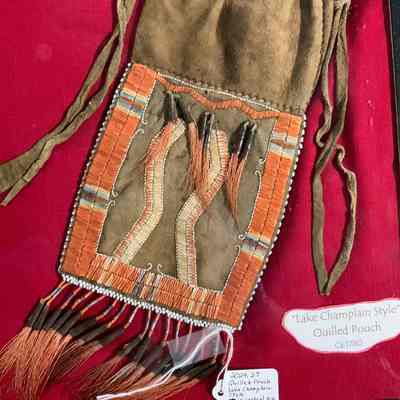

Quilled Pouch
Name/Title
Quilled Pouch
Lexicon
Clothing/Dress/Costume Details
Notes
Either Deer or Moose hide
Textile Details
Leather
Porcupine Quill
Hair
Material
Description
Hide pouch with drawstring closure. Decorated with dyed porcupine quills sewn onto the surface of the lower half of the pouch. Red, white, and blue border surrounds two white and red zig-zag vertical forms. Inner edge of the border includes beaded, scrolled forms. Six beaded and red hair drops are attached to the surface of the quilled design. Sixteen more drops are attaches to the bottom seam.
Acquisition
Source (if not Accessioned)
Abenaki Cultural Conservancy
Ethnography
Made/Created
Date made
circa 1780
Entry/Object ID
L2024.3.27
Context
this beautifully quilled object is small but is one of the few known quillwork pieces surviving; and is therefore an exceedingly important example of the genre. Although found in the bureau of an old house in Central New Hampshire, it stylistically dates from the 1760’s-1790’s and from the Lake Champlain Area.
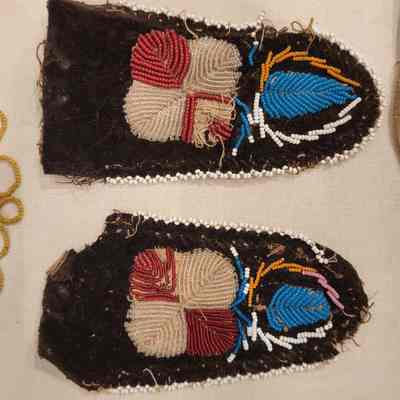

Vamps
Name/Title
Vamps
Lexicon
Description
Two beaded, black velveteen tabs or vamps. The edge of the vamps are bordered by white beads. The central motif features a red and clear quatrefoil design with a blue leaf towards the narrow end (toe) of the vamp. The leaf emerges from a spray of blue and white beads and is surrounded by arms of both yellow and white beads.
Use
Top, decorative panel of moccasins
Acquisition
Accession
1989.10
Ethnography
Made/Created
Date made
1841-1903
Dimensions
Materials
Material
Silk, Beads, Paper
Entry/Object ID
1989.10.6a-b
Context
The distinctive quatrefoil design found on these vamps is indicative of Abenaki bead-work.
These particular pieces came into the Vermont Historical collection as part of a group of items from the Wilbur family. The envelope containing the vamps, along with cuffs 1989.10.7a-b, had the inscription, "James Wilbur's Beadwork." For a number of years, James Wilbur was listed as the maker with an origin date of 1840. Upon further research and close analysis of the beadwork, it's most likely these date from the 1820s and the inscription on the envelope is that of ownership as opposed to manufacture.
The Wilbur family was one of the early settler families in Waterville. 19th century Waterville written histories as well as recorded oral histories indicate there was a sizeable Abenaki village along the shores of the North Branch of the Lamoille River (called the Kelley River at the time). Wilbur's father-in-law, Isaac Merrick, is known to have partnered with Abenaki in his cross-boarder trade/smuggling in the 1810s and 1820s. A beautiful, Abenaki-produced, compass case belonging to Isaac Merrick is also part of this larger family gift. For more information on this relationship, please see object 1989.10.3.
It's highly likely that these vamps, and the now-missing moccasins, were produced in the local Abenaki community and gifted or traded to the extended Wilbur family.
These particular pieces came into the Vermont Historical collection as part of a group of items from the Wilbur family. The envelope containing the vamps, along with cuffs 1989.10.7a-b, had the inscription, "James Wilbur's Beadwork." For a number of years, James Wilbur was listed as the maker with an origin date of 1840. Upon further research and close analysis of the beadwork, it's most likely these date from the 1820s and the inscription on the envelope is that of ownership as opposed to manufacture.
The Wilbur family was one of the early settler families in Waterville. 19th century Waterville written histories as well as recorded oral histories indicate there was a sizeable Abenaki village along the shores of the North Branch of the Lamoille River (called the Kelley River at the time). Wilbur's father-in-law, Isaac Merrick, is known to have partnered with Abenaki in his cross-boarder trade/smuggling in the 1810s and 1820s. A beautiful, Abenaki-produced, compass case belonging to Isaac Merrick is also part of this larger family gift. For more information on this relationship, please see object 1989.10.3.
It's highly likely that these vamps, and the now-missing moccasins, were produced in the local Abenaki community and gifted or traded to the extended Wilbur family.